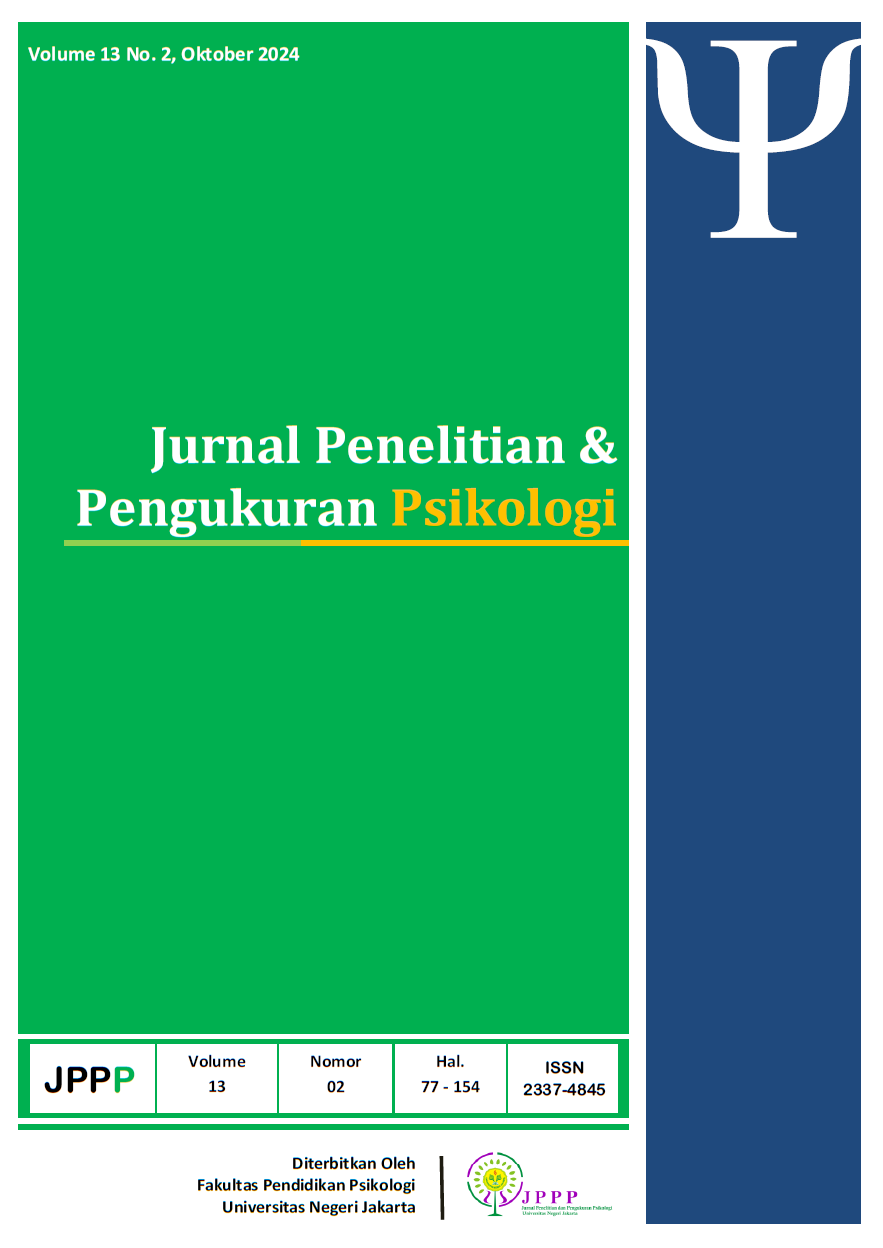Validasi Alat Ukur Frekuensi Photo Manipulation di Indonesia: Perspektif Rasch Model
DOI:
https://doi.org/10.21009/JPPP.132.07Keywords:
frekuensi photo manipulation, rasch model PCM, edit fotoAbstract
Penelitian ini bertujuan untuk mengembangkan alat ukur frekuensi photo manipulation atau manipulasi foto dan eksplorasi variabel demografi terhadap frekuensi manipulasi foto. Pengembangan alat ukur ini menggunakan perspektif analisis Rasch Model data politomus dengan partial credit model (PCM). Skala frekuensi manipulasi foto ini memiliki tiga dimensi yaitu photo filters use, body image manipualtion, dan facial image manipulation. Skala frekuensi manipulasi foto pada tahap awal terdiri dari 14 item dengan skala likert 4 opsi jawaban. Partisipan yang terlibat dalam penelitian ini terdiri dari 228 orang dengan rentang usia mulai dari 18 sampai lebih dari 30 tahun. Hasil dari penelitian ini menunjukkan bahwa asumsi unidimensionalitas, local indepenence, fit statistics dan reliabilitas yang bisa diterima. Setiap threshold berfungsi dengan baik secara monoton ke arah yang diharapkan. Hasil uji differential item function didapatkan item 4 dan item 7 tidak berfungsi dengan baik.
References
Adams, R. J., Wilson, M., & Wang, W. (1997). The multidimensional random coefficients multinomial logit model. Applied Psychological Measurement, 21(1), 1–23. https://doi.org/https://doi.org/10.1177/0146621697211001
Andersen, E. B. (1973). A goodness of fit test for the Rasch model. Psychometrika, 38(1), 123–140.
Andrich, D., & Marais, I. (2019). A course in rasch measurement theory: measuring in the educational, social and health sciences. Springer.
Aristantya, E. K., & Helmi, A. F. (2019). Citra Tubuh pada Remaja Pengguna Instagram. Gadjah Mada Journal of Psychology (GamaJoP), 5(2), 114. https://doi.org/10.22146/gamajop.50624
Azwar, S. (2021). Penyusunan skala psikologi (3rd ed.). Pustaka Pelajar.
Beos, N., Kemps, E., & Prichard, I. (2021). Photo manipulation as a predictor of facial dissatisfaction and cosmetic procedure attitudes. Body Image, 39, 194–201. https://doi.org/10.1016/j.bodyim.2021.08.008
Bond, T. G., & Fox, C. M. (2015). Applying the rasch model: fundamental measurement in the human sciences (3rd ed.). Routledge.
Chou, Y., & Wang, W. (2010). Checking dimensionality in item response models with principal component analysis on standardized residuals. Educational and Psychological Measurement, 70(5), 717–731. https://doi.org/10.1177/0013164410379322
de Ayala, R. J. (2022). The theory and practice of item response theory (T. D. Little (ed.); 2nd ed.). The GuilfordPress.
Ewing, M. T., Salzberger, T., & Sinkovics, R. R. (2005). An alternate approach to assessing cross-cultural measurement equivalence in advertising research. Journal of Advertising, 34(1), 17–36. https://doi.org/10.1080/00913367.2005.10639181
Felig, R. N. (2020). Editing the Self Away The Effects of Photo Manipulation on Perceptions of the Self. In ProQuest Dissertations Publishing. University of South Florida.
Fischer, G. H. (1987). Applying the principles of specific objectivity and of generalizability to the measurement of change. Psychometrika, 52(4), 565–587.
Fiske, L., Fallon, E. A., Blissmer, B., & Redding, C. A. (2014). Prevalence of body dissatisfaction among United States adults: Review and recommendations for future research. Eating Behaviors, 15(3), 357–365. https://doi.org/https://doi.org/10.1016/j.eatbeh.2014.04.010
Gerbing, D. W., & Anderson, J. C. (1988). An Updated Paradigm for Scale Development Incorporating Unidimensionality and Its Assessment. Journal of Marketing Research, 25(2), 186. https://doi.org/10.2307/3172650
Gioia, F., McLean, S., Griffiths, M. D., & Boursier, V. (2021). Adolescents’ selfie-taking and selfie-editing: A revision of the photo manipulation scale and a moderated mediation model. Current Psychology, 3460–3476. https://doi.org/10.1007/s12144-021-01702-x
Linacre, J. M. (1994). Sample size and item calibration stability. Rasch Measurement Transactions, 7(4), 328. https://www.rasch.org/rmt/rmt74m.htm
Linacre, J. M. (1999). Investigating rating scale category utility. Journal of Outcome Measurement, 3(2), 103–122.
Linacre, J. M. (2023). A user’s guide to winsteps® ministep: rasch-model computer programs. https://www.winsteps.com/a/Winsteps-Manual.pdf
Lonergan, A. R., Bussey, K., Mond, J., Brown, O., Giffiths, S., Muray, S. B., & Mitchison, D. (2019). Me, my selfie, and I: The relationship between editing and posting selfies and body dissatisfaction in men and women. Body Image, 28, 39–43. https://doi.org/10.1016/j.bodyim.2018.12.001
Masters, G. N. (1982). A rasch model for partial credit scoring. Psychometrika, 47(2), 149–174.
McLean, S. A., Paxton, S. J., Wertheim, E. H., & Masters, J. (2015). Photoshopping the selfie: Self photo editing and photo investment are associated with body dissatisfaction in adolescent girls. International Journal of Eating Disorders, 48(8), 1132–1140. https://doi.org/10.1002/eat.22449
Moodley, P., & Mthembu, S. N. (2020). Portrayal of black women’s hair-beautification practices in six South African news reports: a close textual reading. African Identities, 18(1–2), 193–216. https://doi.org/10.1080/14725843.2020.1761289
Nunnally, J. C., & Bernstein, I. H. (1994). Psychometric theory (3rd ed., Vol. 1). McGraw-Hill, Inc.
Perline, R., Wright, B. D., & Wainer, H. (1979). The rasch model as additive conjoint measurement. Applied Psychological Measurement, 3(2), 237–255. https://doi.org/10.1177/014662167900300213
Pichardo, M. C., Cano, F., & Garzón-umerenkova, A. (2018). Self-regulation questionnaire (SRQ) in Spanish adolescents: factor structure and rasch analysis. Frontiers in Psychology, 9(August), 1–14. https://doi.org/10.3389/fpsyg.2018.01370
Rahayu, W., Hayat, B., & Putra, M. D. K. (2023). Analisis rasch: aplikasi dan interpretasi. UNJ Press.
Rasch, G. (1966). An item analysis which takes individual differences into account. The British Journal of
Mathematical and Statistical Psychology, 19(1), 49–57.
Suryadi, B., Hayat, B., & Putra, M. D. K. (2020). Evaluating psychometric properties of the Muslim Daily Religiosity Assessment Scale (MUDRAS) in Indonesian samples using the Rasch model. Mental Health, Religion and Culture, 23(3–4), 331–346. https://doi.org/10.1080/13674676.2020.1795822
Tiggemann, M., Anderberg, I., & Brown, Z. (2020). Uploading your best self : Selfie editing and body dissatisfaction. Body Image, 33, 175–182. https://doi.org/10.1016/j.bodyim.2020.03.002
Wright, B. D., & Masters, G. N. (1982). Rating scale analysis: rasch measurement. Mesa Press.
Yen, W. M. (1984). Effects of local item dependence on the fit and equating performance of the three-parameter logistic model. Applied Psychological Measurement, 8(2), 125–145. https://doi.org/10.1177/014662168400800201







